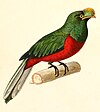| Plesiocathartes Temporal range: | |
|---|---|
| Scientific classification | |
| Domain: | Eukaryota |
| Kingdom: | Animalia |
| Phylum: | Chordata |
| Class: | Aves |
| Order: | Leptosomiformes |
| Genus: | † Plesiocathartes Gaillard, 1908 [1] |
| Type species | |
| †P. europaeus Gaillard, 1908 | |
| Other species [2] | |
Plesiocathartes is an extinct genus of birds that lived during the Eocene to Oligocene period. It currently presents 5 species from Europe and North America. It was originally described related to New World vultures, but recent studies have uncovered that the genus was more closely related to the cuckoo-roller from Madagascar. [3]







